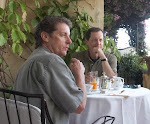The next morning, I had a quick breakfast at my hotel and caught the shuttle back to the airport to rent a car. Upgraded to a nice new Alfa Romeo, I tossed in my luggage, made sure I remembered how to put a manual transmission into reverse, snapped my GPS into position on the windshield, and headed north, away from Rome. This, itself, was an achievement. Rome is my favorite city in the world, and to be so close and not to drop in was killing me, but I had promises to keep.
In a little more than an hour, I was turning off the highway to head west to the shore, where I crossed a causeway onto the island of Monte Argentario. My GPS took me straight to my hotel, the “Filippo II” on the north side of the island.
The Filippo II sits alone on a beautiful promontory looking out over the bay of Porto Santo Stefano. It is an impressive hotel in every way, and not terribly expensive. My room was a living room, kitchenette, and bedroom, all having floor to ceiling sliding glass windows that opened onto a large private balcony that looks out over the gulf.
But hotel resorting was not my objective for stopping over on this island for my first “true” day in Italy. When I was settled into my room, and after a quick shower and change of clothes, I jumped into my car and began driving clockwise around the island to the south side and Porto Ercole.
 The “port of Hercules” is definitely a magnet for yachters, with clear blue water, hundreds of boats moored or anchored in the bay, protective castles from past ages guarding the port from high positions above the bay. I was here, however, because of something that happened here 400 years earlier.
The “port of Hercules” is definitely a magnet for yachters, with clear blue water, hundreds of boats moored or anchored in the bay, protective castles from past ages guarding the port from high positions above the bay. I was here, however, because of something that happened here 400 years earlier. Michelangelo Merisi (known now as “Caravaggio”) was a scoundrel, a drinker, and a reckless brawler who had killed a man in Rome in the late 1500s. He was also one of the greatest artistic geniuses of all time. He had painted great masterworks for the Church in Rome, and for rich patrons like Ciriaco Mattei, but after a drunken duel and charges of manslaughter, he had to flee Rome and find refuge in other countries across the Mediterranean which were not directly controlled by the angry Pope.
As his fame grew in exile, the Pope in 1610 finally forgave all and asked Caravaggio to return to Rome and produce even greater masterpieces than before. He was only too happy to accept the church’s invitation. He packed his bags and recent artworks, and headed from Sicily back to his beloved Rome.
All we know from history is that his ship, for reasons that are not clear, steered off course and landed north of the mouth of the Tiber, in a small port called Porto Ercole. There, the great artist, with the next phase of his life lying gloriously ahead of him, died of what was described as a fever.
In October 2005, I was visiting Rome with Lou and Kay Strubeck. They wanted to see the Sistine Chapel in the Vatican. I decided to spend that time seeing some of the Caravaggio paintings located in Rome – a kind of Easter egg hunt. My first stop was the great cathedral of Santa Maria Del Popolo in upper Rome. As I climbed the steps to this great church, a priest was welcoming visitors at the door. I greeted him saying, “Excuse me, but does this church have works of Caravaggio inside?”
“Yes, signore, it does,” seeming almost to roll his eyes to the sky as if having to indulge a child.
“Where can I find them,” I asked.
“Signore,” he replied, “Whenever you want to see a Caravaggio, just go into the church and go to wherever all the people are.” The clear indication was that this great church, with hundreds of masterpieces – any one of which would be a major tourist attraction in a “regular city” like Dallas, Texas, was constantly being flooded by throngs who only wanted to see the works of one artist.
Sure enough, I walked into this grand cathedral. Two people stood over on the left side of the sanctuary, one person on the right, and about forty people were down at the far end of the church, in the left corner. I walked to where “all the people” were and saw the magnificent Crucifixion of Peter, and the Conversion of Saul. After that, Caravaggio would always be my favorite Italian painter.









